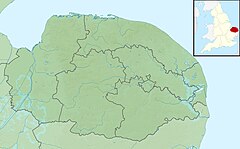
A watermill or water mill is a mill that uses hydropower. It is a structure that uses a water wheel or water turbine to drive a mechanical process such as milling (grinding), rolling, or hammering. Such processes are needed in the production of many material goods, including flour, lumber, paper, textiles, and many metal products. These watermills may comprise gristmills, sawmills, paper mills, textile mills, hammermills, trip hammering mills, rolling mills, wire drawing mills.

The River Eden in West Kent is a tributary of the River Medway. It travels through the Weald of Kent from the border with Surrey, rising from the source in Titsey parish, Surrey, grid reference TQ 420 551, about 350 metres north of Clacket Lane motorway services, and flowing eastward through the Wealden clay to join the River Medway near Penshurst, Kent, grid reference TQ 537 434. The section from its source to where the Gibbs Brook joins it is also known as the Broadmead Water. Its name is a back formation deriving from Edenbridge, the main town through which it flows, and which was originally called in the Old English language "Eadhelmsbrigge".

A penstock is a sluice or gate or intake structure that controls water flow, or an enclosed pipe that delivers water to hydro turbines and sewerage systems. The term is inherited from the earlier technology of mill ponds and watermills.

The River Glaven in the eastern English county of Norfolk is 10.5 miles (16.9 km) long and flows through picturesque North Norfolk countryside to the North Sea. Rising from a tiny headwater in Bodham the river starts 2½ miles before Selbrigg Pond where three small streams combine. The scenic value of the Glaven valley is important to the tourist industry in North Norfolk. The river is one of over 200 chalk rivers in the world and one of 160 in the UK.
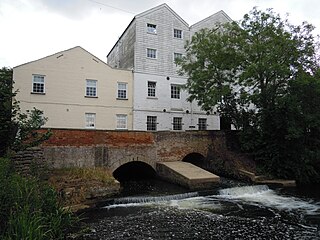
Buxton Mill, is located on the River Bure about 0.5 miles (0.80 km) east of the village of Buxton, Norfolk, and is in the hamlet of Lamas, Norfolk. A watermill was recorded here in the Domesday Book. The present mill is thought to date from 1754 and was built by William Pepper, a merchant living in Buxton.
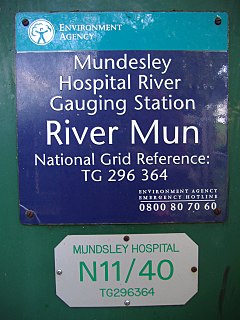
The River Mun or Mundesley Beck is a river in the north of the county of Norfolk, England. The source of the river can be found in the Parish of Northrepps. The river finally runs into the North Sea in the village of Mundesley.

The River Ingol is a small river in the west of the English county of Norfolk.

Scarrow Beck is a minor watercourse which rises in the north of the English county of Norfolk. It is a tributary of the River Bure. It's spring is in the North Norfolk village of Aylmerton west of the main street. It eventually merges, after 7.7 miles (12.4 km) with the River Bure at Ingworth just north of the Blickling Hall estate. There are two watermills on the beck, both of which are no longer in working order. A third windmill at Gresham stands on Gur Beck, a small tributary of Scarrow Beck.
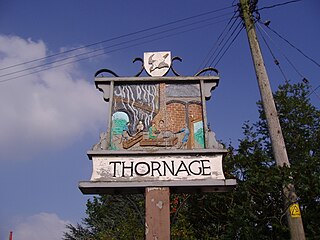
Thornage is a village and a civil parish in the English county of Norfolk. The village is 2.7 miles south-west of Holt, 23.2 miles north-west of Norwich and 11.3 miles east of Fakenham, and straddles the B1110 road between Holt and Guist. The nearest railway station is at Sheringham for the Bittern Line which runs between Sheringham, Cromer and Norwich. The nearest airport is at Norwich International Airport.
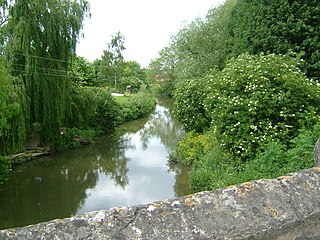
The River Beult is a tributary of the River Medway in South East England. It has several sources west of Ashford, including one at Woodchurch. It then flows through Headcorn. At Hunton, 7 furlongs (1.4 km) above Yalding, it is joined by the major stream of the River Teise. Town bridge lies 10 1⁄4 miles (16.5 km) from Allington, it is the longest mediaeval bridge in Kent. The river enters the Medway at Yalding. The River Beult is crossed by the railway between Headcorn and Staplehurst. The bridge was the scene of the Staplehurst rail crash in 1865 in which Charles Dickens was involved.
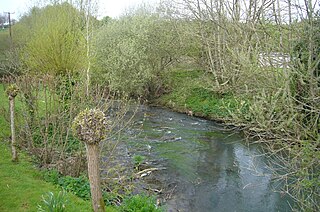
The Bybrook, also known as the By Brook, is a small river in England. It is a tributary of the Bristol Avon and is some 12 miles (19 km) long. Its sources are the Burton Brook and the Broadmead Brook, which rise in South Gloucestershire at Tormarton and Cold Ashton respectively, and join just north of Castle Combe in Wiltshire. The river has a mean flow rate of 57.25 cubic feet per second (1.621 m3/s) as recorded at Middlehill near Box. A variety of flora and fauna is supported by the river including the endangered white-clawed crayfish. Twenty watermill sites have been identified on the river but none now remain in use.

Letheringsett watermill is situated on the River Glaven in the village of Letheringsett within the English county of Norfolk. Letheringsett is in the district of North Norfolk and is 1.4 miles (2.3 km) west of the town of Holt. The watermill is a Grade II* listed building and is the last fully operational watermill in Norfolk that produces flour.

Glandford watermill is situated on the River Glaven a little north of the village of Glandford within the English county of Norfolk. Glandford is in the civil parish of Wiveton within the district of North Norfolk.

The remains of Letheringsett Brewery Watermill are located in the centre of the village of Letheringsett in the county of Norfolk. The watermill of 1784 was housed within the maltings and brewery complex founded and run by John Brereton of Letheringsett Hall from before 1721. Much of this complex still stands on the south side of the A148 Cromer to King’s Lynn road, which bisects the village on an east-west axis, and on the west bank of the River Glaven, which bisects the village south-north.
The Medway and its tributaries and sub-tributaries have been used for over 1,150 years as a source of power. There are over two hundred sites where the use of water power is known. These uses included corn milling, fulling, paper making, iron smelting, pumping water, making gunpowder, vegetable oil extraction, and electricity generation. Today, there is just one watermill working for trade. Those that remain have mostly been converted. Such conversions include a garage, dwellings, restaurants, museums and a wedding venue. Some watermills are mere derelict shells, lower walls or lesser remains. Of the majority, there is nothing to be seen. A large number of tributaries feed into the River Medway. The tributaries that powered watermills will be described in the order that they feed in. The mills are described in oder from source to mouth. Left bank and right bank are referred to as though the reader is facing downstream. This article covers the tributaries that feed in above Penshurst.
The Medway and its tributaries and sub-tributaries have been used for over 1,150 years as a source of power. There are over two hundred sites where the use of water power is known. These uses included corn milling, fulling, paper making, iron smelting, pumping water, making gunpowder, vegetable oil extraction, and electricity generation. Today, there is just one watermill working for trade. Those that remain have mostly been converted. Such conversions include a garage, dwellings, restaurants, museums and a wedding venue. Some watermills are mere derelict shells, lower walls or lesser remains. Of the majority, there is nothing to be seen. A large number of tributaries feed into the River Medway. The tributaries that powered watermills will be described in the order that they feed in. The mills are described in order from source to mouth. Left bank and right bank are referred to as though the reader is facing downstream. This article covers the watermills on the tributaries that feed in below Penshurst and above Yalding.

Hunworth is a village within the civil parish of Stody(where the population is from 2011 included) in the English county of Norfolk. The village is 11.5 miles (18.5 km) east-north-east of the town of Fakenham, 12.6 miles (20.3 km) west-south-west of Cromer and 125 miles (201 km) north-north-east of London. The nearest town is Holt which lies 3.4 miles (5.5 km) north of the village. The nearest railway station is at Sheringham for the Bittern Line which runs between Sheringham, Cromer and Norwich. The nearest airport is Norwich International Airport. The village is situated on the road between Holt and Briston. The parish of Stody, within which Hunworth is located, had, in the 2001 census, a population of 101, being less than 100 at the 2011 Census. For the purposes of local government, the parish falls within the district of North Norfolk.

The International Wind- and Watermill Museum, at Gifhorn in the German state of Lower Saxony, is the only one of its kind in Europe. On the museum's open-air site, which covers an area of around 16 hectares, there are currently 16 mills from 12 different countries. The mills are either original or faithful reproductions and are set in landscapes typical of their origins. Right across the site are historic artefacts associated with mills and the milling industry. The museum site is easily accessed by road; nearby is the intersection between the B 4 and B 188 federal highways. The museum is station 65 on the Lower Saxon Mill Road.

Narborough Watermill is located on the river Nar, within the village of Narborough in the English county of Norfolk. The watermill is thought to have been built around 1780 and is a Grade II listed building

For centuries, the watermills on the Zala river had co-existed in a single harmonious unity with each other as well as with the river, the Zala valley and Zala meadow, both latter ones renowned for their beauty. Landscape rehabilitation would indeed be necessary because due to the closure of the mills and the destruction of the sluices, the level of the ground water in the meadows, usually having very loamy soil, has dramatically decreased, which has had detrimental impacts on the condition of the meadows. The declining tendency in the grassland culture hasn’t helped either. What is more, in several cases parts of the meadows were turned into arable lands or industrial sites. The final blow to the deteriorating meadows that gradually grew characterless was dealt by the disgraceful regulation of the river Zala in the beginning of the 1960s. A further station of the process was the elimination of the mills from the life of the river for all. „There were about 200 known steam mills and watermills in the county Zala at the end of the 1800s (Molnár 2015). According to the statistical data of the Zala county archives of the year 1949, there were about 180 mills in operation in the county then. In the beginning of the 1940s, there were still about 37 mills grinding on the river Zala. One can still find water in some old mill-ponds. For the history of a miller's family see Jakosa 2011, 2012, both in Hungarian). These ponds provide suitable habitat for some aquatic organisms. As for the history of the published data and photos, I. Hajdu, J. Izsák, Á. Jakosa, Gy. Kummer and Mrs. M. Marx, the latter working with Göcseji Muzeum, Zalaegerszeg decided in 2004 to start gathering documents and data systematically on the watermills along the river Zala. We have based our selection of the mills to be presented on a list from the year 1949 preserved in the Zala-county archives. The chart was provided by Mr. Gy. Kummer. A significant number of the photos were also taken by him. The mills indicated by red characters exist today mainly in documents and in the mind's eye only. For the possibility of hydropower by the water of small rivers, e.g. Zala, see Gerse 2014.

